Breath of Music: The Rise, Fall, and Revival of the Harmonica
Discover how the harmonica traveled from 19th-century Europe to the heart of American and Mexican music, shaped popular culture, faded from the spotlight, and is now making an unexpected comeback through passionate creators in the digital age.
Koyal Melodies
5/29/202514 min read
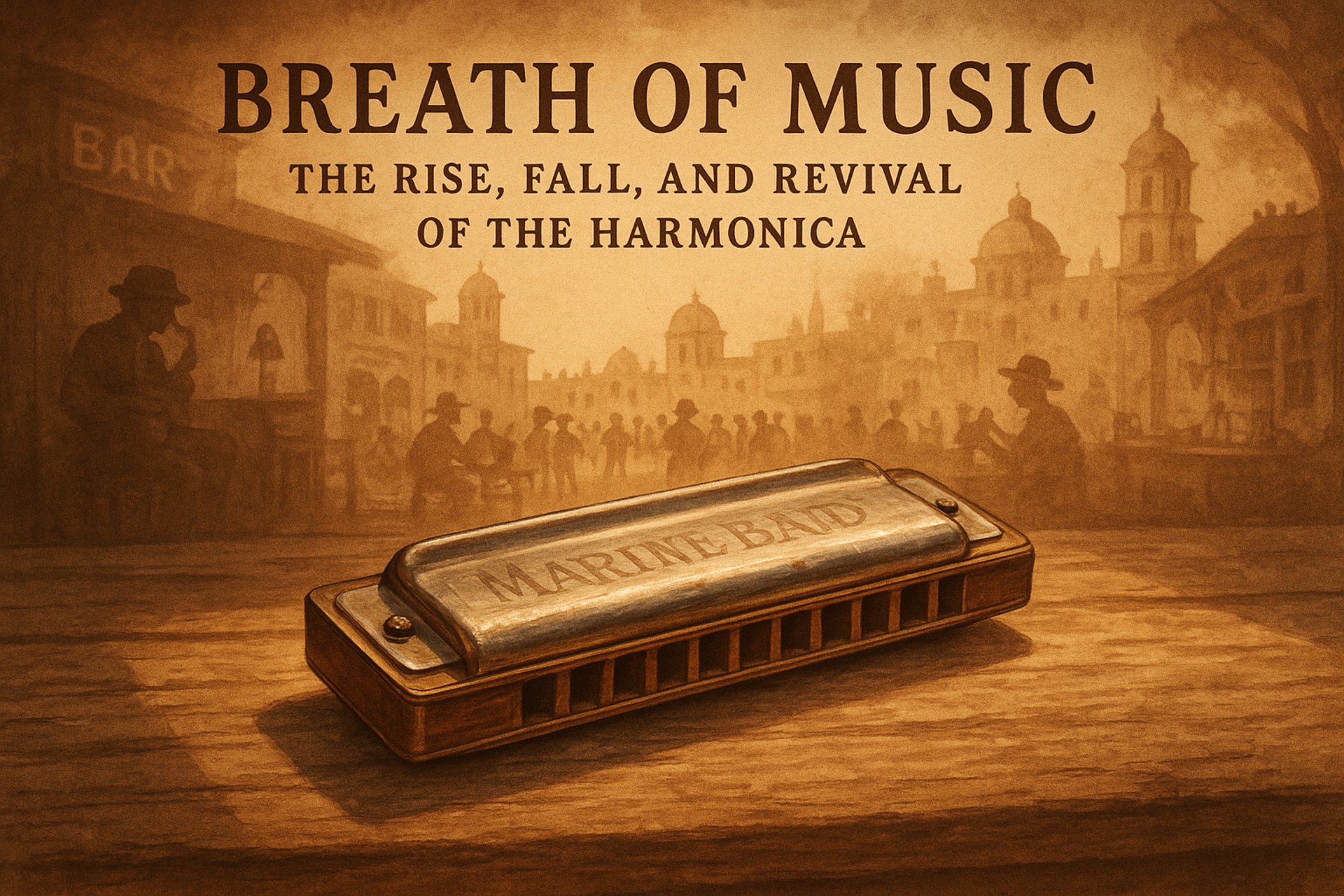
Introduction
There are some instruments whose sound you recognize in an instant—a piano’s sparkle, a guitar’s strum, the lonely call of a distant trumpet. But there’s another voice, soft yet unforgettable, that slips through the cracks of popular memory: the harmonica.
Often tucked into a pocket, pulled out around a campfire, or echoing across a city street, the harmonica is the world’s most portable music-maker. It has travelled continents, survived wars, and lent its “breath” to every genre from backwoods blues to mariachi, from the heart of Chicago to the hills of Oaxaca. For decades, it was a mainstay of both American and Mexican music—so much so that for many, its sound is the very spirit of the open road, the border town, or the bustling plaza.
Yet, for all its legacy, the harmonica is now mostly remembered as a relic—a quirky prop in old films, or the signature sound of a few bluesy legends. It’s easy to forget how it once shaped popular music, or how it became a lifeline for countless working-class musicians. Even fewer people realize that today, in the age of digital everything, the harmonica is quietly making a comeback—not through sold-out stadiums, but in YouTube bedrooms, on street corners, and among creators with nothing but a laptop and a passion for its soulful sound.
This is the story of the harmonica: its remarkable rise, its slow decline, and its surprising revival in the hands of everyday musicians and small-time YouTubers. It’s a story about music, technology, migration, memory—and above all, the enduring human need to create something beautiful out of a single breath.
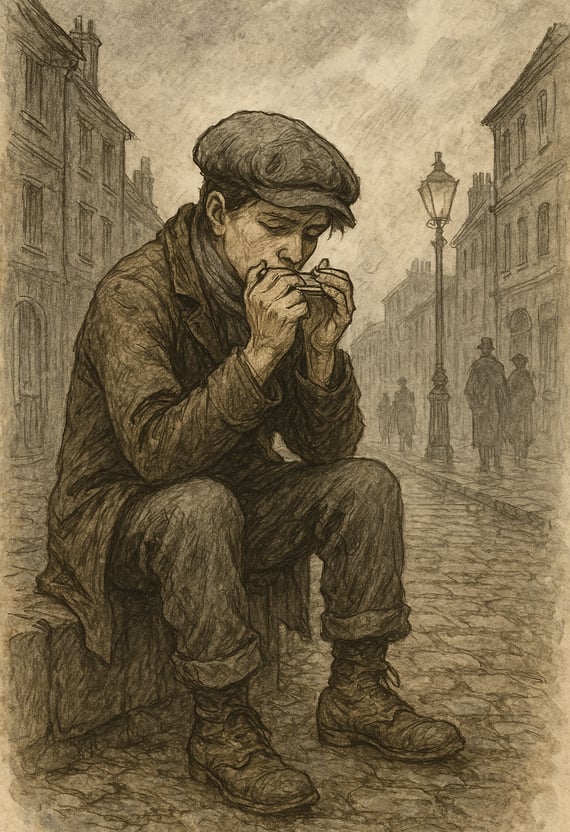

Chapter I: The Birth of the Harmonica
It began not with a roar, but with a whisper—a simple, reedy note in a small German workshop. In the early 19th century, Europe was a continent in flux: revolutions and new ideas swept through the streets, industry hummed, and people moved farther and faster than ever before. Out of this restless energy, a new sound was born.
The harmonica’s story traces back to the 1820s, in the German town of Trossingen. While several inventors played a part, one name stands out: Christian Friedrich Ludwig Buschmann, a young instrument maker who, in 1821, built what he called the “aura”—an early mouth-blown reed instrument. Others, like Joseph Richter, soon improved upon Buschmann’s design, adding the key feature of allowing both blow and draw notes (breathing in and out), which became the basis for the modern harmonica.
The appeal was immediate. Unlike cumbersome pianos or expensive violins, the harmonica fit easily in a pocket. It was inexpensive to produce, sturdy, and—most of all—astonishingly expressive for its size. Anyone, from a shoemaker’s apprentice to a wandering laborer, could own one.
By the mid-1800s, harmonica workshops were springing up throughout Germany. The most famous name to emerge was Matthias Hohner, who founded his factory in 1857. Hohner’s business acumen—and clever use of industrial mass production—turned the harmonica from a local novelty into a global sensation. In the decades that followed, millions of harmonicas crossed borders, packed in the bags of immigrants, traders, and soldiers.
This tiny instrument found its voice on the move: on dusty roads, in railway cars, and at lonely campfires. In Germany, it became the music of workers and dreamers. But the harmonica was destined for even bigger stages.
As steamships crossed the Atlantic and waves of Europeans sought new lives in the Americas, the harmonica traveled with them. Soon, its plaintive sound would mingle with the folk melodies of the American South, the rhythms of Mexico, and the blues rising up from the banks of the Mississippi.
But before it conquered the New World, the harmonica’s journey was already a symbol of the age: small, adaptable, and full of the promise of new beginnings. What started as an experiment in a quiet German workshop was about to become the soundtrack of migration, memory, and change.


Fun Facts & Figures from the Harmonica’s Birth
• The Original “Mouth Organ”:
Early harmonicas were often called “mouth organs” or “handäoline” in German. The term “harmonica” comes from the Greek word for “harmonious”—a nod to its ability to play chords as well as melodies.
• Simple, Yet Ingenious:
A basic harmonica consists of a series of thin metal reeds, each tuned to a specific note. When the player blows or draws air through the holes, the reeds vibrate, producing sound. Its simplicity made it cheap and easy to manufacture—perfect for the working class.
• The Hohner Legacy:
By the late 19th century, Matthias Hohner’s factory was producing over a million harmonicas each year. Hohner became a household name, and his instruments remain popular to this day.
• A Global Traveler:
The harmonica quickly spread far beyond Germany, finding its way to Russia, France, Britain, and even China. Its portability and affordability made it the people’s instrument, transcending language and borders.
• Early Stars:
While the earliest harmonica players remain largely anonymous, the instrument soon inspired virtuosos—like Adolph Molnar and the early “mouth organ clubs” of Vienna and Berlin. These groups staged some of the world’s first harmonica concerts.
• Technical Note:
Most early harmonicas were diatonic (playing in a single key), but soon chromatic models were developed, allowing for more complex music—including classical and jazz.
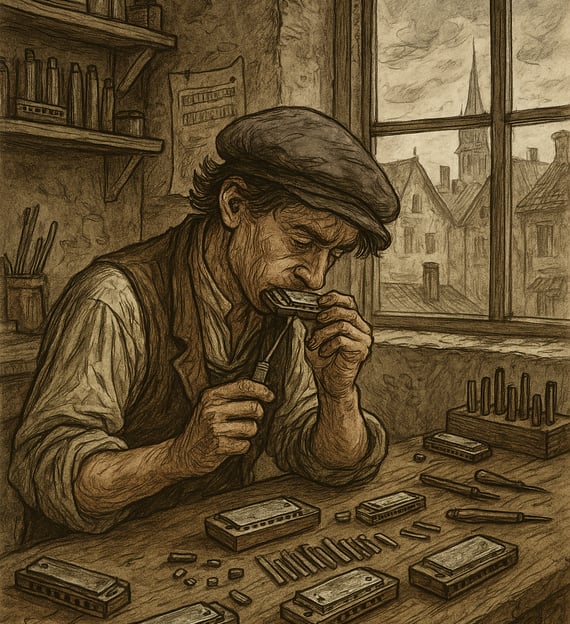

Chapter II: The Golden Age of Harmonica
As the 19th century gave way to the 20th, the harmonica’s gentle voice found itself echoing far beyond the towns and workshops of its German homeland. Millions of people, swept up in waves of migration and transformation, carried this tiny instrument into the heart of new worlds. It was here, amid railroads, bustling ports, and the great unknown, that the harmonica would truly come alive.
A Soundtrack for the Masses
By the late 1800s, harmonicas were being exported by the crate-load. Hohner alone sent tens of millions of units to the United States, South America, Asia, and beyond. For many immigrants, the harmonica was a pocket-sized piece of home—a comfort on long journeys and a companion in strange new lands.
In the United States, the harmonica found fertile ground. The instrument was affordable, tough, and easy to learn—perfect for the working class and rural poor. Soldiers carried them into the Civil War and, later, into the trenches of World War I. Out on the vast American frontier, harmonicas rang out around campfires, in cattle drives, and on dusty porches. It soon became a staple in folk music, spirituals, and old-time tunes that defined the American soundscape.
The Harmonica Goes Blues
But it was in the African-American communities of the American South that the harmonica underwent its most radical transformation. In the hands of sharecroppers and laborers, it took on the wailing, soul-deep tones of the blues. Techniques like “bending” notes and rapid-fire “chugging” gave the harmonica a voice as expressive and raw as any singer.
Names like Sonny Boy Williamson, Little Walter, and Big Walter Horton would later become synonymous with blues harmonica virtuosity. They didn’t just play the instrument—they made it speak, cry, and shout. Their music set the template for generations to come, influencing everything from rock and roll to modern R&B.
A Global Instrument
Across the Atlantic, the harmonica flourished in unexpected places. In Mexico, it found a home in folk music, norteño, and even mariachi bands, sometimes called the “armónica.” Musicians like Los Tigres del Norte incorporated its bright, punchy sound into songs that told stories of migration and border life.
In South America, Asia, and Eastern Europe, harmonica clubs sprang up, staging competitions and concerts. Vienna, Berlin, and Shanghai all saw the rise of virtuoso harmonica ensembles, playing everything from classical to jazz.
From Parlors to Pop Culture
By the 1930s and 40s, the harmonica’s appeal had crossed every social line. It was found in the hands of street buskers and in lavish radio orchestras. John Lennon learned his first melodies on a Hohner. Bob Dylan made the harmonica the badge of the folk revival. In Mexico, rural and urban musicians alike made it part of the soundtrack of everyday life.
Harmonica clubs, competitions, and variety acts (like the famous Borrah Minevitch and His Harmonica Rascals) drew huge crowds and brought the instrument to early cinema and radio. Advertisements boasted the harmonica as the ideal gift for “every boy”—a democratic instrument for a new, modern age.
The Little Giant
The harmonica was now everywhere: on the radio, in nightclubs, on battlefields, and on the open road. Its music stitched together communities across continents—an everyman’s companion, a tool for survival, and an engine for dreams.
Yet even as its popularity soared, change was coming. New sounds and new technologies were about to reshape the world of music once again. For a moment, though, the harmonica was king—a little instrument with a giant voice.
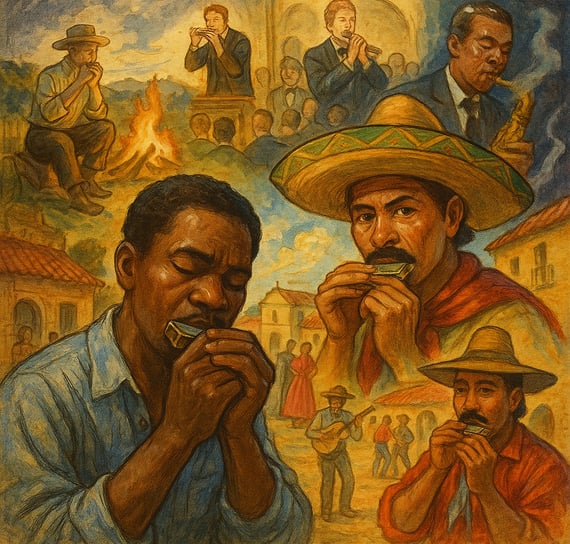

Harmonica Highlights from the Golden Age
Famous Faces and Virtuosos:
Sonny Boy Williamson (I & II): Pioneers of blues harmonica whose recordings set the gold standard.
Little Walter: Revolutionized Chicago blues with electrified harmonica.
Borrah Minevitch: Led the world’s most famous harmonica vaudeville act, The Harmonica Rascals.
Los Tigres del Norte: Blended harmonica into modern Mexican norteño and folk.
Key Songs:
“Juke” by Little Walter — the first harmonica instrumental to top the R&B charts.
“Midnight Special” — a folk classic where the harmonica takes the lead.
Countless mariachi and norteño tunes where the harmonica carries the melody.
Did You Know?
The harmonica was one of the very first instruments played in space—astronaut Wally Schirra brought one on the Gemini 6 mission in 1965, performing “Jingle Bells” in orbit.
Harmonica clubs and competitions became global—by the 1930s, Vienna, Shanghai, and New York all hosted harmonica orchestras.
Bob Dylan’s harmonica holder was invented in the 1940s, making it possible for singer-songwriters to play guitar and harmonica at the same time.
Harmonica in Popular Culture:
Movie soundtracks, from spaghetti westerns to animated classics, often use the harmonica for a sense of nostalgia, wandering, or the open road.
Harmonicas became common gifts for children and soldiers alike—cheap, durable, and guaranteed to bring music anywhere.
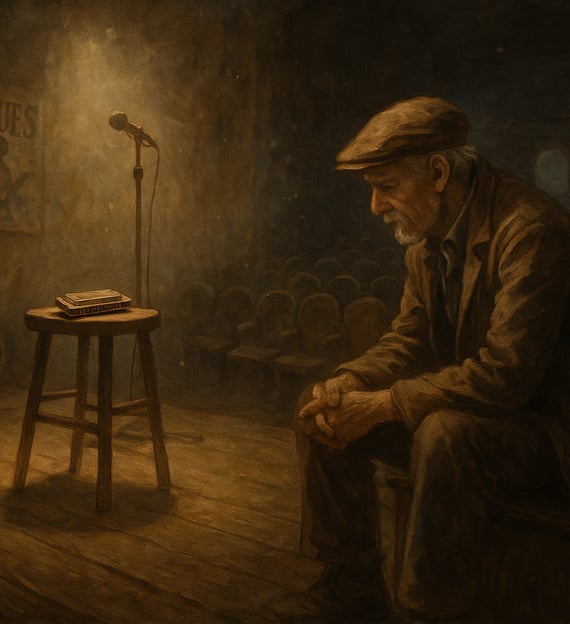

Chapter III: The Decline
By the late 1960s, the harmonica—a mainstay of campfires, nightclubs, and radio hits—began to fade from the center stage it once commanded. The reasons were both cultural and technological, intertwined with the rapid changes sweeping the world of music.
Changing Sounds, Changing Tastes
The music industry was transforming fast. The 1970s and 80s brought electric guitars, synthesizers, drum machines, and an ever-growing appetite for new sonic textures. Rock bands pushed for louder, bolder sounds; disco and pop thrived on polished production. Amid these shifts, the humble harmonica began to sound old-fashioned—its gentle breath and bluesy wail overshadowed by the electrified roar of modern bands.
For many, the harmonica became a symbol of the past: of dusty roads, sepia-toned photographs, and a slower, more rustic era. It still made guest appearances—sometimes on a Dylan or Springsteen album, or as a nostalgic flourish in movie soundtracks—but it was rarely the star.
Lost in the Shuffle
There were deeper reasons, too. The harmonica had always been the people’s instrument: cheap, portable, and accessible. But as musical education shifted toward “serious” instruments (piano, guitar, drums), and as consumer tastes followed the spectacle of arena concerts and MTV, fewer young musicians reached for the harmonica. In schools, it was often seen as a toy, not a serious tool for creative expression.
Manufacturers, once thriving, scaled back production. Famous names like Hohner and Lee Oskar weathered difficult decades. Harmonica orchestras and clubs—once so vibrant in Europe, the US, and Asia—saw dwindling membership and audience interest. The instrument that had united generations began to fade into the background noise of progress.
Still, a Flicker Remained
Yet even as the crowds disappeared, the harmonica never truly died. It found shelter in the margins: with street musicians, blues aficionados, folk traditionalists, and stubborn romantics who refused to let its voice vanish. For some, the harmonica was a secret talisman—a way to connect with memory, with family, or with a vanished world.
Sometimes, in the quiet corners of a festival or in a smoky bar on the edge of town, a single harmonica could hush a room, reminding everyone that music’s power isn’t measured in decibels or chart positions, but in the stories and emotions it brings to life.
A Pause—Not an Ending
As the 20th century drew to a close, few would have guessed that the harmonica’s story was far from over. Even in its decline, the instrument had left an indelible mark on world music, and in the hands of a new, digital generation, its gentle breath was about to find new life.
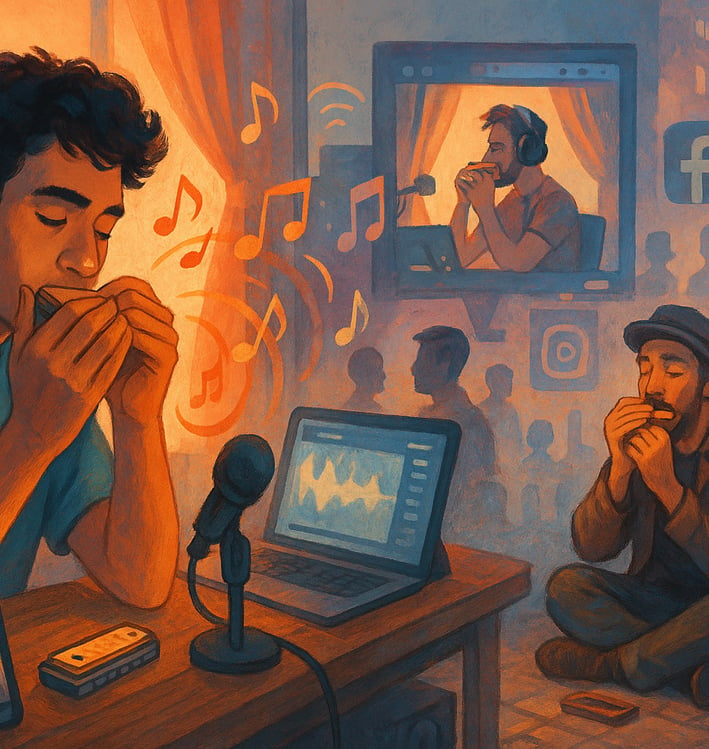

Echoes from the Margins—Harmonica’s Quiet Years
• Last Great Solos:
Even as its popularity waned, the harmonica featured in iconic moments—like Stevie Wonder’s soulful solos in “Isn’t She Lovely” and “For Once in My Life,” and the haunting harmonica in Bruce Springsteen’s “Thunder Road.”
The instrument made surprise appearances in 80s and 90s pop, from Billy Joel’s “Piano Man” to movie soundtracks like “Once Upon a Time in the West.”
• The Blues Never Died:
While pop and rock moved on, the harmonica remained at the core of the blues revival—artists like James Cotton and Charlie Musselwhite kept the spirit alive on festival stages and late-night radio.
• Words from the Wise:
“The harmonica will never die. It’s the people’s instrument. You can take it anywhere, and you don’t need electricity—just soul.”
— Charlie Musselwhite
• Niche Communities:
Small harmonica festivals, like SPAH (Society for the Preservation and Advancement of the Harmonica) in the US, continued to attract die-hard fans, keeping a fragile but vibrant culture alive.
Online forums, even in the early days of the internet, became havens for players to swap tips, stories, and encouragement.
• Still a Universal Gift:
Through decades of change, harmonicas remained a beloved gift—easy to find in music shops, toy stores, and even Christmas stockings around the world.


Chapter IV: The Digital Revival
If the 20th century ended with the harmonica fading from the spotlight, the dawn of the 21st brought an unexpected twist: the world’s most portable instrument began quietly returning—not through the grand halls of fame, but through the small screens and speakers of the digital age.
From Bedrooms to the World
As music creation shifted from studios to bedrooms, the barriers to sharing music all but disappeared. Affordable recording gear, easy-to-use software, and global platforms like YouTube, Facebook, and Instagram opened a new stage for everyone. Here, the harmonica found its way into the hands of a new generation—one less interested in labels, and more excited about authenticity and experimentation.
It was here, in low-lit rooms and makeshift studios, that the harmonica’s voice returned: as part of lo-fi hip-hop beats, indie folk recordings, and bluesy covers streamed to audiences worldwide. Street musicians who once played for spare change now streamed live, connecting with fans across continents. Small-time YouTubers began to upload tutorials, performances, and harmonica “challenges,” their passion finding a community that transcended borders and language.
The Rise of the Hobbyist and the Micro-Star
The harmonica’s digital revival wasn’t driven by superstars or record labels—it was a movement of hobbyists, enthusiasts, and everyday creators. Some played traditional tunes passed down from family; others explored entirely new genres, adding harmonica to jazz, EDM, even video game soundtracks. Platforms like Reddit, TikTok, and harmonica forums buzzed with tips, questions, and stories—supporting a new wave of self-taught players.
Online shops began to sell affordable harmonicas and accessories. Digital tools could mimic the instrument, but true players still cherished the tactile, breathy feel of the real thing. The harmonica became, once again, the people’s instrument: democratic, humble, and full of possibility.
Small Audiences, Big Impact
Though few digital harmonica channels go viral, their collective impact is profound. For some, picking up the harmonica offered comfort in loneliness or stress; for others, it was a creative outlet or a bridge to forgotten roots. Some creators blended cultures, adapting Mexican melodies for blues harp, or fusing American folk with Asian pentatonics. The instrument became both a relic and a symbol of modern DIY spirit.
This new world wasn’t about mass fame, but about connection. Through comments, live streams, and virtual jams, harmonica players forged friendships and revived traditions. In a noisy era of instant content, the harmonica’s simple, soulful voice cut through—reminding listeners of music’s power to soothe, unite, and inspire.
The Harmonica’s Next Verse
No one knows if the harmonica will ever regain its place in pop culture’s limelight. But in the hands of creators across bedrooms, parks, and city streets, its revival is real—and its legacy is being rewritten, one breath at a time.


Final Chapter: The Harmonica’s Next Verse
After nearly two centuries, the harmonica has traveled a path unlike any other instrument—born in humble workshops, rising to fame in smoky bars and open fields, nearly vanishing in a world obsessed with the new, and then quietly returning through the power of small voices and global connection.
The harmonica’s journey is, in many ways, a mirror of our own. It’s an instrument that thrives on movement and migration, on resilience and reinvention. It survived wars, crossed oceans, and wove itself into the fabric of folk tales and family memories in places as different as Mississippi and Michoacán. Even as its sound faded from pop charts and glossy music magazines, it never lost its place in the hands—and the hearts—of those who needed it most.
Today, the harmonica is experiencing a true revival, not through celebrity or industry, but through the creative force of ordinary people. Bedroom musicians, street performers, YouTube creators, and digital hobbyists are not just keeping the harmonica alive—they’re writing its future. They experiment, blend styles, cross borders, and prove that music’s power lies in its ability to connect and express what words cannot.
Perhaps the harmonica will never again rule the airwaves, and maybe that’s just as well. Its magic has always belonged to those who seek out its sound—a whistle of hope on a lonely journey, a song for a quiet night, or a chorus that turns strangers into friends. As long as there are stories to tell and emotions to share, there will be a place for the harmonica.
So, if you’re holding one now—or even just thinking of it—remember: you are part of a much bigger story, breathing new life into a timeless tradition. The harmonica’s next verse is waiting to be played, and it starts with you.


How to Start: Your First Steps with the Harmonica
Curious about adding your own note to the harmonica’s long story? Here’s how to begin—no experience required.
1. Choose Your First Harmonica
Pick up a simple diatonic harmonica in the key of C. These are inexpensive, widely available online or in music shops, and great for learning the basics.
2. Just Breathe
Unlike most instruments, the harmonica rewards you for simply breathing in and out. Place your lips gently over a few holes and blow or draw (breathe in) to make notes. Don’t overthink it—just explore the sound!
3. Try a Simple Tune
Start with something familiar, like “Oh! Susanna” or “Twinkle Twinkle Little Star.” There’s no need to read music—just match the melody by ear, one breath at a time.
4. Tap Into Free Resources
There are hundreds of free harmonica tutorials on YouTube. Search for “harmonica for beginners” or “how to play [your favorite song] on harmonica.” Many instructors break things down into easy, step-by-step lessons.
5. Join the Community
Consider joining online harmonica forums or Facebook groups. You’ll find encouragement, advice, and even virtual jam sessions. The harmonica community is famously welcoming!
6. Make It a Habit
You don’t need hours of practice. Carry your harmonica with you and play for a few minutes here and there. On a walk, while waiting for coffee, or when you need a break.
7. Enjoy the Journey
Every player finds their own sound. Experiment, play along with your favorite music, and most of all—have fun. There are no mistakes, just new discoveries.
Your story starts with a single note. Give it a try—the world is waiting to hear your music.
